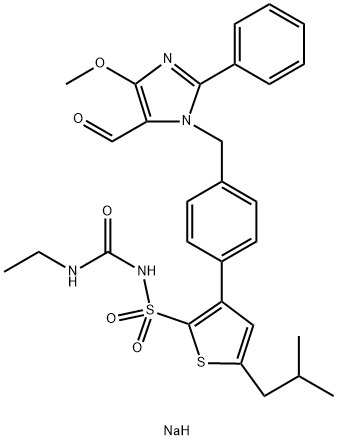306288-04-0
 306288-04-0 结构式
306288-04-0 结构式
基本信息
N-[(乙基氨基)羰基]-3-[4-[(5-甲酰基-4-甲氧基-2-苯基-1H-咪唑-1-基)甲基]苯基]-5-异丁基-2-噻吩磺酰胺单钠盐
AVE0991.Na salt
AVE 0991 (sodiuM salt)
ethylcarbamoyl-[3-[4-[(5-formyl-4-methoxy-2-phenylimidazol-1-yl)methyl]phenyl]-5-(2-methylpropyl)thiophen-2-yl]sulfonylazanide
N-[(Ethylamino)carbonyl]-3-[4-[(5-formyl-4-methoxy-2-phenyl-1H-imidazol-1-yl)methyl]phenyl]-5-(2-methylpropyl)-2-thiophenesulfonamide monosodium salt
常见问题列表
IC50: 21±35 nM (Ang-(1-7) receptor)
AVE 0991 is a nonpeptide compound that evokes effects similar to Ang-(1-7) on the endothelium. AVE 0991 and unlabeled Ang-(1-7) compete for high-affinity binding of [ 125 I]-Ang-(1-7) to bovine aortic endothelial cell membranes with IC 50 s of 21±35 and 220±280 nM, respectively. Peak concentrations of NO and O 2 - release by AVE 0991 sodium salt and Ang-(1-7) (both 10 μM) are not significantly different (NO: 295±20 and 270±25 nM; O 2 - : 18±2 and 20±4 nM). However, the released amount of bioactive NO is ≈5 times higher for AVE 0991 in comparison to Ang-(1-7).
AVE 0991 (0.58 nmol/g) produces a significant decrease of water diuresis in WT mice compared with vehicle-treated animals (0.06±0.03 mL versus 0.27±0.05; n=9 for each group; P<0.01). The antidiuretic effect of AVE 0991 (AVE) is associated with an increase in urine osmolality (1669±231.0 mOsm/KgH 2 O versus 681.1±165.8 mOsm/KgH 2 O in vehicle-treated mice; P<0.01). The genetic deletion of Mas abolishes the antidiuretic effect of AVE 0991 during water loading (0.37±0.10 mL [n=9] versus 0.27±0.03 mL [n=11] in AVE 0991-treated mice). As observed with C57BL/6 mice, administration of AVE 0991 (0.58 nmol/g) in water-loaded Swiss mice also produces a significant decrease of the urinary volume compared with vehicle-treated animals (0.13±0.05 mL [n=16] versus 0.51±0.04 mL [n=40]; P<0.01). One week of treatment with AVE-0991 produces a significant decrease in perfusion pressure (56.55±0.86 vs. 68.73±0.69 mmHg in vehicle-treated rats) and an increase in systolic tension (11.40±0.05 vs. 9.84±0.15 g in vehicle-treated rats), rate of tension rise (+dT/dt; 184.30±0.50 vs. 155.20±1.97 g/s in vehicle-treated rats), rate of tension fall (−dT/dt; 179.60±1.39 vs. 150.80±2.42 g/s in vehicle-treated rats). A slight increase in heart rate (HR) is also observed (220.40±0.71 vs. 214.20±0.74 beats/min in vehicle-treated rats.